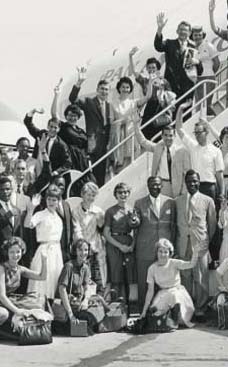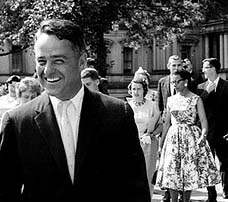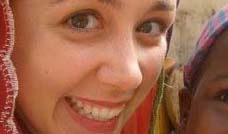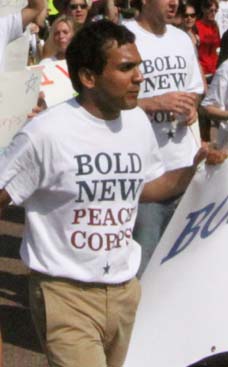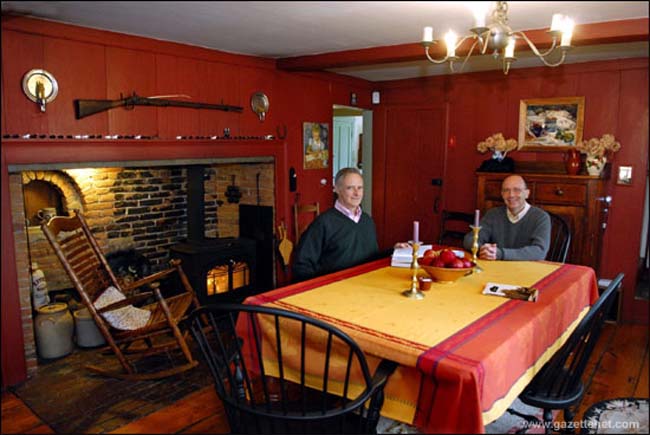
Miller, who spent time in the Peace Corps in Zaire (now the Democratic Republic of the Congo), has hung Kente cloth and other African artifacts on his study walls. He teaches in the African-American department at Yale as well as the French department, focusing on Francophone Africa and the Caribbean. He said his grandfather imported lumber from the Ivory Coast after World War I. The house has an interesting history. A handmade sign on the back of the house reads "Ferry Homestead 1748," but the men think it was probably built about 40 years later. The real estate agent told them that the house was built for a minister of the Granby Congregational Church. Granby split off from South Hadley in 1762 and called its first minister in 1768, the Rev. Simon Backus, nephew of the famed Northampton preacher, Jonathan Edwards. The house evidently was built as an enticement for his successor, the Rev. Benjamin Chapman, who arrived in 1789. Chapman was finally dismissed in 1796 because of failing health. Two years earlier his two-year-old son, Newton Whittelsey Chapman, had died. "You can't but wonder if the death of his little boy had an effect on his health," Miller said. The men found the boy's tombstone in the Granby graveyard and a rubbing from it hangs in the front hall. The Ferrys lived in the house during the 19th century. Capt. Luther Ferry was a furniture and casket maker. The ell that Miller and Rivers call the library was probably Ferry's shop. At one point the house was the site of the Granby lending library; at another, the home of Charles W. Ferry, the town's postmaster. Charles A. Ferry, an 1871 graduate of Yale University, designed the Yale Bowl, built in 1914. "It was the first college stadium with seating all the way around," Miller explained. It was patterned after the Coliseum in Rome and was second only to that historic stadium in size.
Congo Kinshasa RPCV Chris Miller adds to the history to his 18th-century home
Parsonage with a past: Granby couple add their history to 18th-century home
By CHERYL B. WILSON Bulletin Contributing Writer
Published on December 17, 2010
Caption: Chris Miller, left, and Chris Rivers sit in the keeping room of the historic Granby home they bought in 1996. Photo: Gordon Daniels
It's very simple, warned Chris Rivers when he agreed to allow his 18th-century home in Granby to be featured in Valley Houses. And it is - simply lovely.
From the steep pitch of the saltbox roof to the warm hearth in the keeping room to the intriguing Roman numerals on log beams in the attic, this simple farmhouse is elegant and charming.
In 1996, Rivers and his then partner Chris Miller hadn't planned on buying a house. In fact they were about to leave on a trip to Rome when a friend at lunch, giving them tips on the Eternal City, mentioned a wonderful property for sale in Granby. The two men called the real estate agent to view the 18th-century farmhouse.
"The minute we walked through the door we were goners," recalled Miller recently. Two weeks later he and Rivers bought the Ferry Homestead, built in 1789. The men were married in 2004.
The keeping room, the first room they saw, clinched the deal. The paneling is painted Colonial red. With a huge fireplace, now fitted with a woodstove, wide-board floors and windows overlooking meadows and a distant view of mountains, it just seemed like home.
The room opens into a large sunny living room with another fireplace and more paneling plus a small ell they call the library, with custom-made bookshelves and a window seat for their Brittany spaniel Rufus.
Fortunately the house had been structurally renovated in the 1950s, including a reconstruction of the central chimney, complete with beehive oven, so little work needed to be done immediately. The men, both French professors, Rivers at Mount Holyoke College and Miller at Yale University, were able to settle into the house and plan the decoration slowly.
The keeping room is the heart of the house with an adjacent small but efficient kitchen. A large table with a country tablecloth and Windsor dining chairs sits in front of the hearth, along with a rush-seated ladder-back rocking chair. A simple chest of drawers is typical of the antiques in the house - nothing of museum quality, but very appropriate to the ambiance.
Marching along the mantelpiece are tiny bulls, ornaments taken from Spanish wine bottles - white from the white wines, red from the red and brown from the roses.
Starting as a parsonage
The house has an interesting history. A handmade sign on the back of the house reads "Ferry Homestead 1748," but the men think it was probably built about 40 years later. The real estate agent told them that the house was built for a minister of the Granby Congregational Church.
Granby split off from South Hadley in 1762 and called its first minister in 1768, the Rev. Simon Backus, nephew of the famed Northampton preacher, Jonathan Edwards. The house evidently was built as an enticement for his successor, the Rev. Benjamin Chapman, who arrived in 1789.
Chapman was finally dismissed in 1796 because of failing health. Two years earlier his two-year-old son, Newton Whittelsey Chapman, had died. "You can't but wonder if the death of his little boy had an effect on his health," Miller said. The men found the boy's tombstone in the Granby graveyard and a rubbing from it hangs in the front hall.
The Ferrys lived in the house during the 19th century. Capt. Luther Ferry was a furniture and casket maker. The ell that Miller and Rivers call the library was probably Ferry's shop.
At one point the house was the site of the Granby lending library; at another, the home of Charles W. Ferry, the town's postmaster. Charles A. Ferry, an 1871 graduate of Yale University, designed the Yale Bowl, built in 1914.
"It was the first college stadium with seating all the way around," Miller explained. It was patterned after the Coliseum in Rome and was second only to that historic stadium in size.
'Granby green' paneling
The living room has another large fireplace. Wing chairs flank a comfortable sofa in front of the hearth. A tall, slim end table, carved with a floral motif, came from Miller's Swiss ancestors. Folk art portraits of Rivers' ancestors line the walls.
The paneling is painted a distinctive soft green-blue. "It's a very personal story," said Rivers. "We call the color Granby Green."
It was mixed specially for them at a paint store in Holyoke that has since gone out of business. They went back numerous times to have the paint remixed until they got the exact shade they wanted. "There were similar shades but they were always in tones of blue," said Miller. "We wanted green."
Authentic reproduction wrought iron hardware throughout the house was crafted by Williamsburg Blacksmiths. The company made the andirons in the fireplace, a floor lamp beside the sofa and all the hinges and drawer pulls. "For a while we were going there every week," Miller said.
The other room on the first floor is a bedroom with a charming old spool bed. The wallpaper came from a store in Boston that specializes in reproduction 18th- and 19th-century wall coverings. Later they saw the paper in a different color in a museum house at Strawbery Banke in Portsmouth, N. H.
A narrow, angled staircase leads to the second floor. Hanging in the stairwell is a faded antique quilt, which Rivers said was made by his great-great-grandmother in the 1880s for a bachelor son. A brass hanging lantern lights the staircase.
Blending old and new
Upstairs is another bedroom, two studies and a bathroom the men designed themselves. They wanted to keep the roughly chiseled antique ceiling beams in the small bathroom and added a skylight, along with a tub with water jets and a separate shower. The work was done by Valley Home Improvement from Florence.
Each man has his own study. Rivers actually has two since they converted space in the attic to a larger room for him. Rivers has done extensive research on French boxers and is writing a book about one, world light heavy-weight champion Georges Carpentier, who in 1921 had a bout with Jack Dempsey. The walls of his original study are covered with pictures of French boxers.
Miller, who spent time in the Peace Corps in Zaire (now the Democratic Republic of the Congo), has hung Kente cloth and other African artifacts on his study walls. He teaches in the African-American department at Yale as well as the French department, focusing on Francophone Africa and the Caribbean. He said his grandfather imported lumber from the Ivory Coast after World War I.
Recently they converted part of the attic to a larger study for Rivers, complete with heat and sloping wooden ceiling.
The rest of the attic is open storage and Miller was eager to show visitors how the structure of the house is revealed here. Rough logs, some with bark still clinging to them, were matched by checking Roman numerals burnt into the wood. "I love the way they laid out the house on the ground and then put it together," Miller said.
The Roman numerals VII and XIV are clearly visible on the rough logs holding up the ceiling. Miller said that he has heard that if such logs still have bark it is possible to date the building quite accurately, but they have yet to explore that possibility.
Garden and pool
The exterior of the house is painted muted Colonial red. "Every summer we paint a couple of sides of the house," Rivers said.
There is a small back yard, enclosed with authentic split-rail fencing to protect Rufus, their dog. Beyond is a fenced swimming pool that came with the house, a raised-bed vegetable garden and a carriage house converted to a three-car garage. Miller said the old dairy barn reportedly burned to the ground in the 1940s or 1950s. A former neighbor recalled the dramatic blaze.
The old house has become a summer gathering place. "One of the wonderful things is that we have lots of family and friends who also love this house," Rivers said. "We almost run a B&B in the summer. We feel as if the house belongs to a whole community of people."
Cheryl Wilson can be reached at valleygardens@comcast.net









